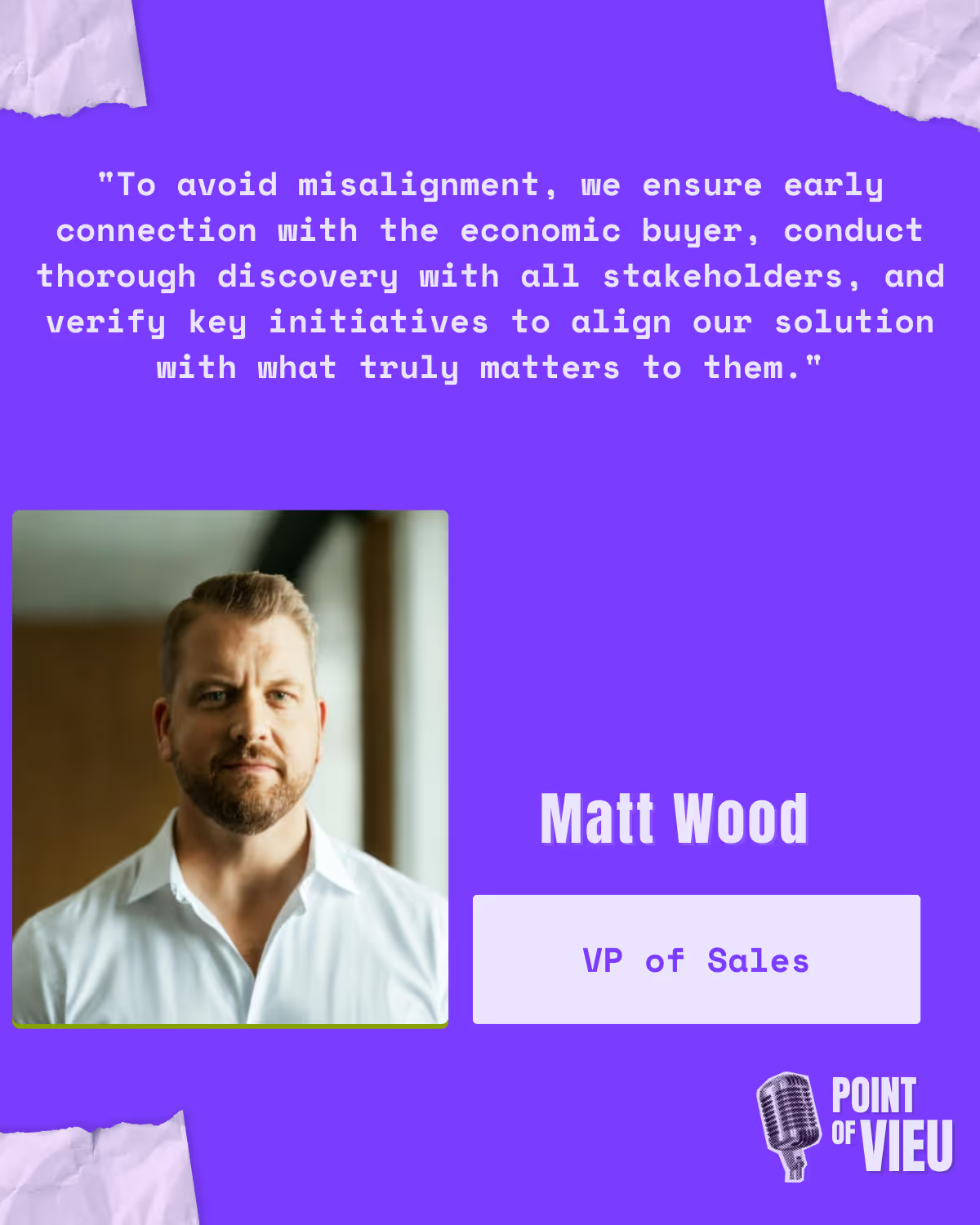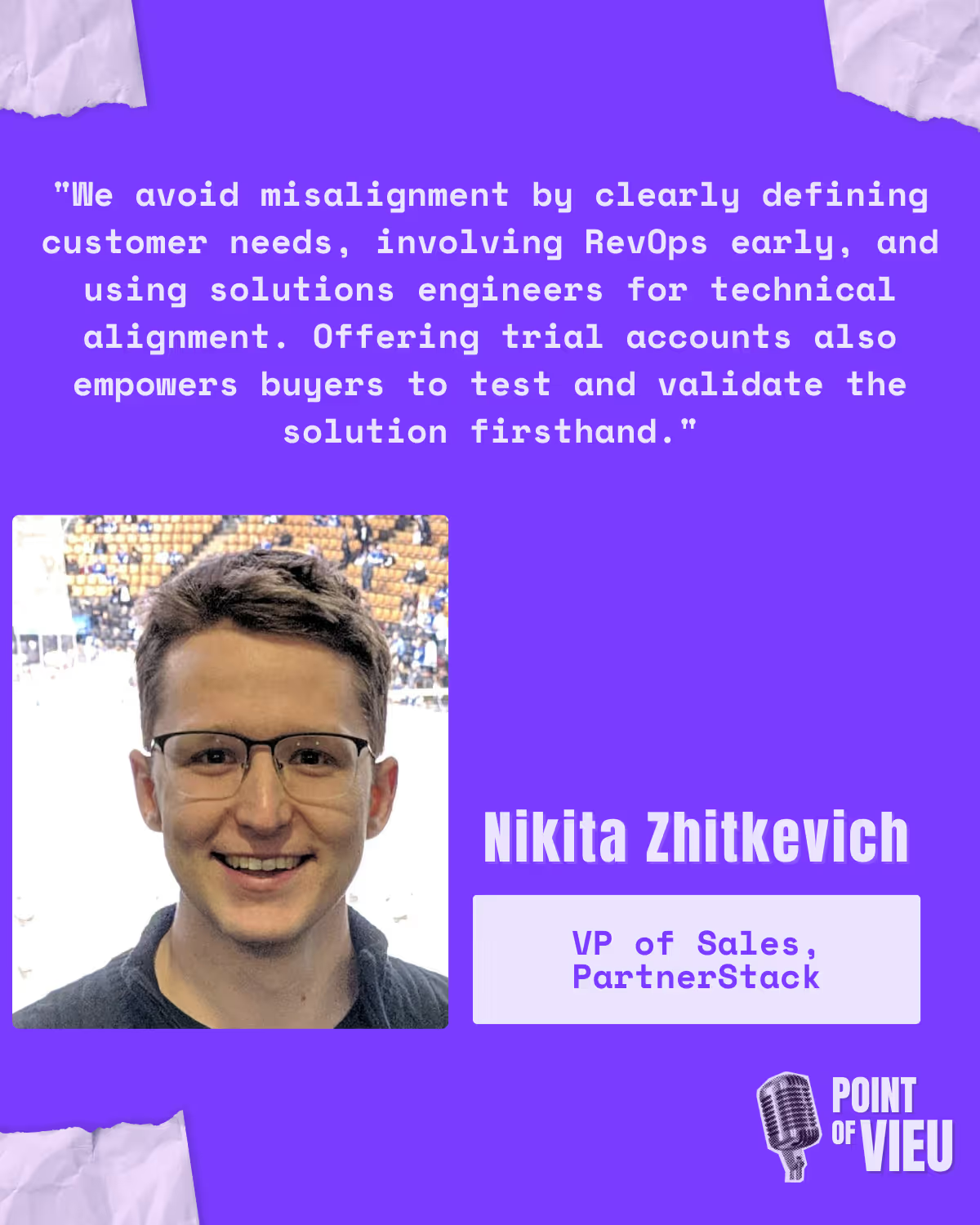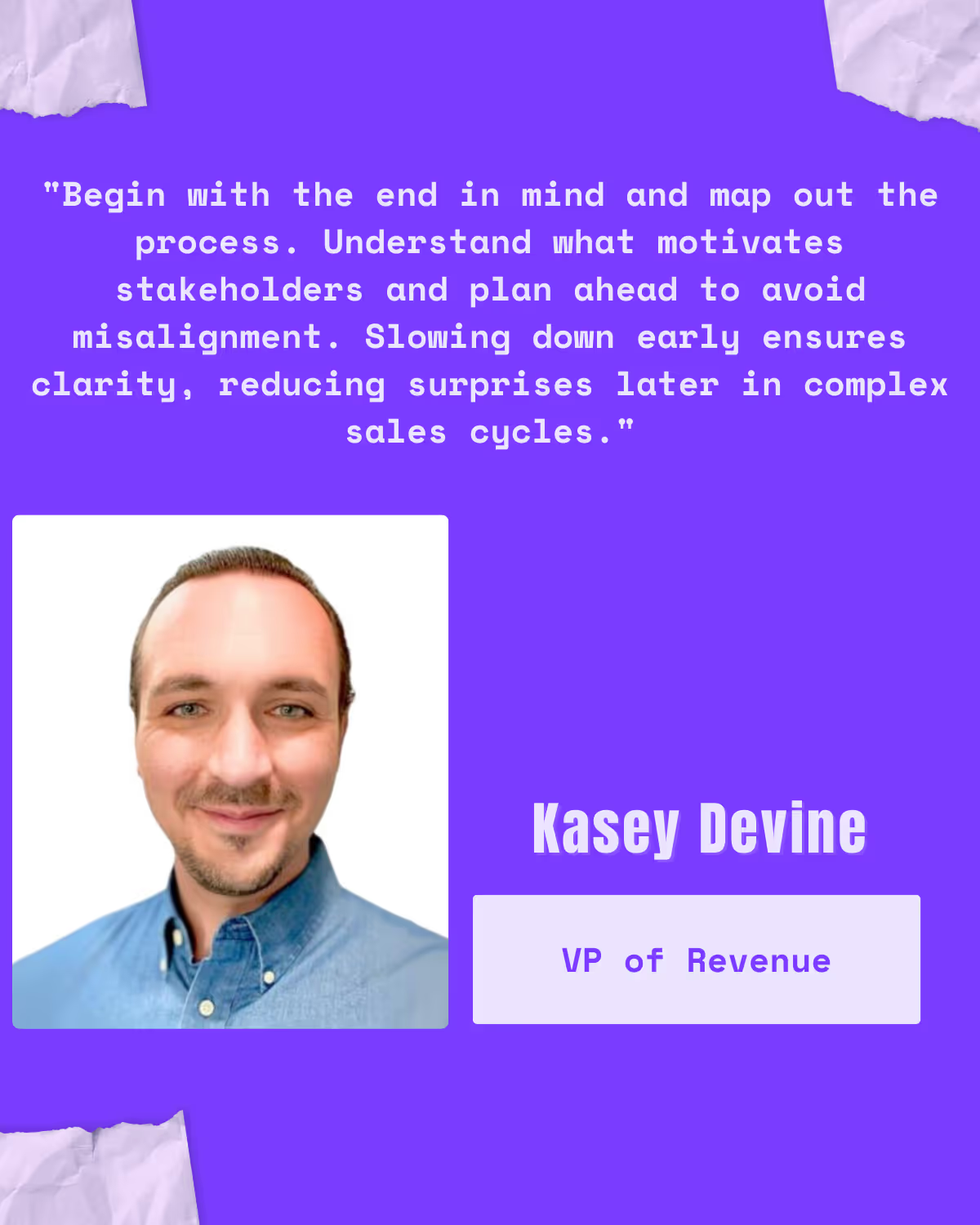In this video, experts share their insights on how they tackle the modern sales landscape, focusing on techniques to avoid misalignment with buying teams.
Experts emphasize the importance of aligning with the buyer's journey and utilizing collaborative solutions like shared workspaces to keep stakeholders on the same page throughout the buying process.
They highlight that transparency and collaboration are essential, concentrating on understanding customer pain points and leveraging solutions engineers to align technical expectations early in the sales process.
Mapping out the result from the start is vital, and slowing down the sales process can lead to better alignment and help avoid surprises down the line.
In the previous six episodes, we discussed the following:
Watch our experts answer the question: "How are you ensuring alignment with buying teams?"
Matt Wood

Matt Wood has spent approximately a decade in SaaS, playing a pivotal role in scaling revenue growth across multiple organizations within DevOps, cybersecurity, and data observability. His efforts have driven revenue from below $1 million to over $100 million, contributing to four successful mergers or acquisitions.
“Yeah, I think you're seeing a significant shift towards aligning with the buyer's journey as opposed to the seller's journey. Instead of solely focusing on the MEDPICC criteria that salespeople must gather, more collaborative solutions are emerging, like shared workspaces where the entire buying process can be organized to ensure alignment with the buyer's journey.
This goes back to the importance of conducting thorough discovery with every stakeholder in the organization to understand the buying process and decision criteria. It's essential to connect with the economic buyer early on and ensure collaboration at every step of the opportunity progression by reiterating back: ‘Here's what I understand.’ ‘Here's what I heard’ and ‘Here's what I think is important.’ It’s crucial to verify that with each stakeholder because their answers may vary, which is important to understand.
Often, when people struggle to reach the economic buyer—something I’ve experienced in multiple opportunities—you may think you understand the key initiatives and priorities driving the decision. But once you reach the economic buyer, you realize there’s another layer you need to address. It’s crucial to ensure that your product and solution align with what truly matters to them and that they solve the problem at hand.”
Jeff Kirchick

Jeff Kirchick is the Vice President of Sales at allwhere, an IT asset lifecycle management software company based in New York City with approximately 45 employees. With 15 years of experience in software sales, Jeff has been a part of multiple successful exits.
“I think there are two ways we can approach this. Even though, as I mentioned earlier, there are many people involved in deals, at the end of the day, you're generally going to be working through a champion or perhaps a couple of champions who share the same motivations. To avoid misalignment, I often work through that individual.
Going back to the example I mentioned earlier, where I want to get in front of the IT leader to ensure they're not going to block my deal, I would first approach my champion and say something like, ‘I’ve found that the IT team can often become a blocker if we don't do X, Y, and Z with them. Do you agree that we should talk to them? If so, can I reach out to them, or would you prefer to broker that conversation?’
It’s important to get them on the same page by explaining why these conversations with their team are necessary and how we could face potential roadblocks. This helps keep everyone aligned by being proactive. Another way to do this is through deal rooms. Platforms like Accord, Recapped, and Aligned are becoming popular, though they’re still in their early stages.
At my company, we use PandaDoc to create rooms where we share all relevant information and proposals, ensuring the right stakeholders have access. This is an effective way to keep everyone aligned. Adoption of this is still in its infancy, but I believe we’ll see these platforms integrated with communication tools like Slack as they evolve.”
Nikita Zhitkevich

Nikita is the VP of Sales at PartnerStack, an organization dedicated to helping companies launch and scale their channel and partner programs across the board.
“We're trying to maintain and continue being very clear with our process, especially during introductory calls. We focus on understanding customer needs and pain points and mapping an ideal solution to what our partners can deliver. It's essential to clarify the end state and what we can realistically achieve. Selling together is also important—you shouldn't sell alone. Bringing in others, whether it's another salesperson or a team member who can accelerate the sale, is crucial. For us, solutions engineers play a key role, diving deep and bringing technical folks into the process.
I find that misalignment often occurs with those implementing the solution internally. RevOps professionals, for instance, have seen a variety of tools implemented, both successfully and unsuccessfully. The sooner you bring them into the cycle and get their buy-in, the faster things will move forward. Additionally, simplifying and accelerating the customer experience is critical. By providing trial accounts and giving them control over the buying process, they can test assumptions and theories about what the tool can actually do. If they’ve done a technical overview, mapped the tool against their existing setup, and aligned it with their ideal solution, there should be minimal misalignment between their expectations and the solution.
Now, organizational changes can happen. A company might buy software and then experience shifts in the buying committee. However, being clear upfront about what the tool can do, while also placing some responsibility on the buyer, ensures transparency and helps avoid confusion or unexpected issues.”
Kasey Devine

Kasey Devine has spent the past 10 years in sales, sales leadership, and go-to-market leadership roles. His diverse experience spans multiple verticals, with a focus on SMBs, particularly in human resources, tech, and outsourcing services.
“I think it's important to begin with the end in mind and map that out, especially given that this is on the rise. It’s prudent to look outside your typical sources for inspiration. One of the resources I’ve found helpful is Chris Voss, who does great work in negotiation. It's tempting to view negotiation as the end of a process, but it’s actually the entire process.
If you can understand what motivates people and focus on what matters to them, you’ll achieve better alignment. In my opinion, and I realize I may be in the minority on this, if you reach a point of misalignment, it likely began much earlier in the sales process than you'd like to admit or recognize.
It’s not something that comes out of nowhere—it seems like it does, but the problem started much earlier. So, my advice is to slow down to speed up. If your contact wants to accelerate the process, don’t take the bait until you have a clear understanding of their side and how you can help them.
The complexity in today’s sales environment arises from the variety of stakeholders, each with different perspectives. That’s not new.
What is new is the greater impact of these decisions. If a company purchases a service or product and misses the mark, the consequences are much worse now, so there are more opinions involved.
Understanding the lay of the land is crucial so you can plan ahead. When you increase the number of people you're talking to, you need to know where everything stands so nothing blindsides you. If something unexpected happens once, you can learn from it, but if it keeps happening, that’s something you need to plan for.”
Conclusion
Sales experts emphasize the importance of transparency, clear communication, and proactive engagement with stakeholders as sales processes become increasingly collaborative.
Sales teams can avoid misalignment by leveraging deal rooms, aligning with champions, and integrating technical teams early in the process. The key lies in understanding customer needs, mapping out solutions, and maintaining flexibility to navigate organizational changes.



